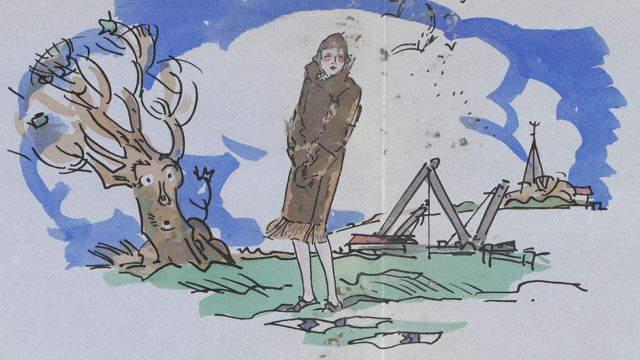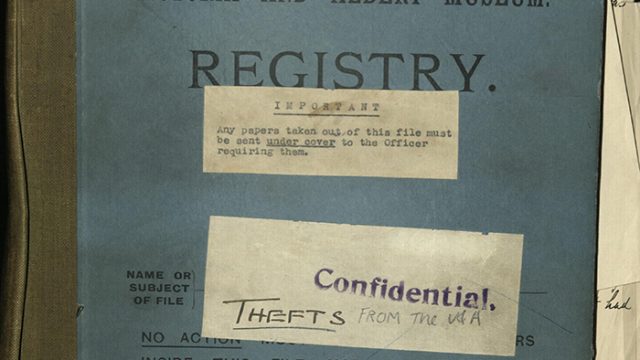“5th June
Interview with Mr Richards and Mr Fussell long discussion with them about the room in which the collection should be placed opposed Mr Fussell’s plan of placing in the back or work room, saw other members of the committee – and it was finally settled that the collection should be exhibited in the Library or first room on entering the building and that the cases should be temporarily placed in the back room until the Library could be got ready the walls of which were not coloured.
Superintended the removal of the van containing the glass showcases from the Town Jail to the New School of Art and the unloading of the same by attendant callow and Gray the Joiners man who places the objects in the West Room beer money 1/-”

The Mr Fussell mentioned is Frederick R Fussell who was Headmaster of the Art School ca. 1849 to ca. 1866.
For much of the next few days Vernon was busy with the preparation of the Library overseeing the alteration of the gas-fittings, moving objects out of the way of workmen, and unpacking the second van.
“10 June
a very anxious day there being no door large enough to admit the entire portion of the [Hampton court] Skreen it was necessary to get it in at the opening of one of the large windows to accomplish which scaffolding had to be erected and pulleys employed the men who undertook it were not experienced or numerous enough therefore the masters were called in to assist the work employed them the entire day”

The Hampton Court Screen which caused Vernon so much trouble was designed by Jean Tijou and made in the 1690s. It was lent to the South Kensington Museum by Queen Victoria as there was no place for the screen after the remodelling of the gardens by George III. The South Kensington Museum in turn lent sections of the Screen to various Art Schools around the country and Nottingham was one of them. There is a Nottingham connection with the Screen as it was once attributed to Huntington Shaw of Nottingham. When the Screen came to the South Kensington Museum a section of it was photographed by a Museum photographer and the image is preserved in one of the Photographic Guardbooks in the V&A Archive.

After much hard work arranging objects, writing labels and text for the exhibition catalogue the exhibition opened at 7pm on Monday 19 June 1865 with a conversazione. Mr Birken read the opening address and music – vocal and instrumental – were provided. Vernon notes that those attending the opening seemed to be chiefly composed of the Friends of the School, “there were few of the clergy and none of the authorities of the town that I could discern”. The audience for the exhibition is a theme that comes up a lot in the diary and I shall be looking more closely at who visited in a later blog post.
“Tuesday June 20th
The Exhibition opened to the public at 10am admission 1/- and remained open until 10 at night the number of visitors was 48 by payment and 49 by season ticket, total 97 – 3 only of the departments catalogues were sold and 33 of the catalogues of the local collections The labelling of the objects does away the necessity of a catalogue Eleven additional Season tickets were sold the total receipts were £6.1.0 I was engaged during the day in making up last weeks reports to forward to department and in compiling the material of the additional half sheet of the catalogue of the Local contributions”
So, why was there an exhibition of objects from the South Kensington Museum in Nottingham? Travelling exhibitions, showing examples of good design and manufacture, had been organised by the Museum since it was established. The first one travelled to 26 towns from 1855 to 1859 and a second larger exhibition visited 15 towns between June 1860 and June 1863. The system was changed in 1864 so that instead of sending exactly the same exhibition to each town, customised exhibitions were put together to reflect the local trades.
Nottingham School of Art was the first government art school to be established outside London. It first opened on 1 April 1843 at the Peoples Hall in Beck Lane, then moved to Plumtree House, Stoney Street and then to Commerce Street in 1858. The foundation stone for a new building on Waverley Street designed by Frederick Bakewell (1825-1881) was laid on 22 October 1863.
The Precis Minutes of the Science and Art Department held by the V&A Archive reveal that Nottingham School of Art received a grant of £750 for the new building on 3 March 1865, the year in which the new building opened. I think that the exhibition looked after by Mr Vernon and described in his diary may be the first exhibition held in the new building – but I will do some more research to see if this is true and let you know.





nice post keep it up realy enjoyed your post